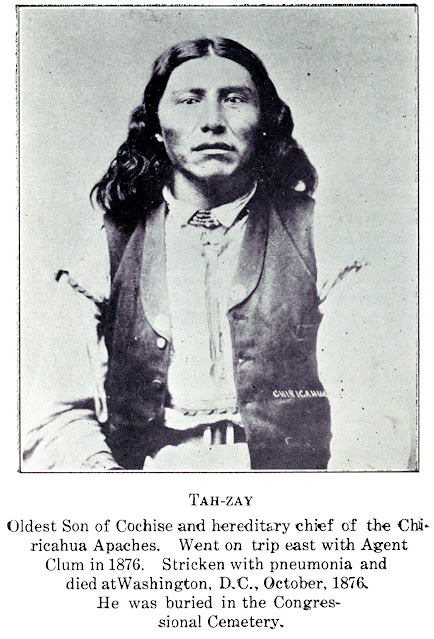Accordingly, on July 15th I addressed a letter to Governor Safford, reminding him of my desire to take some of the most influential Apaches on a tour of "the states" in order that they might better comprehend the magnitude of our country, the vastness of our population and the achievements of our civilization by personal observation and contact, while at the same time many eastern people would have opportunity to acquire a more accurate understanding of the general character of the Apaches, and—as we hoped—a more friendly attitude toward them, and that if the trip was undertaken I hoped to be serving the Indians, the territory and the general government. -- John Clum, Apaches as Thespians in 1876, The New Mexico Historical Review, 1930.
The plan was for chosen leaders of the Apaches to perform dances and tableaux for paying eastern audiences so that the trip would not only pay for itself but turn a profit. As Clum put it, “Furthermore, we would automatically loom as public benefactors-philanthropists, for the reason that we would be affording the Indians the desired benefits of a tour through the vast camping grounds of the pale-face, while contenting ourselves with the problematical returns from the ‘gate.’” This ad for the Olympic Theatre in Saint Louis, for September 8th and 9th 1876, shows the theatrical flavor of those performances.
…our party of Apache tourists included Eskim-in-zin, chief of the Arivaipas, and his wife; Tah-zay (son of Cochise), chief of the Chiricahuas; Diablo, chief of the Coyoteros, and his son-five or six years of age; Sagully, chief of the Yumas, and his wife; Casad ora, a subchief of the Pinals, and his wife; Captain Jim of the agency Indian police force, and his wife. Ten athletic young braves and a boy about twelve years of age completed the group.
However, our visit to Washington was sadly marred by the only tragedy of the trip-the death of the young Chiricahua chief, Tah-zay. Young and strong as he was, Tahzay fell ill with pneumonia, and although the best medical skill available was called to attend him he grew worse rapidly and died within a few days. The funeral services were conducted by Rev. J. E. Rankin of the First Congregational Church of Washington. Among those attending the obsequies were Commissioner of Indian Affairs J. Q. Smith and General O. O. Howard, who, four years previous, had made the treaty of peace with Cochise-the dead Apache's father. The interment was made in the Congressional Cemetery.The illness and death of Tah-zay were not devoid of beneficial results, for the reason that they afforded the Indians with our party an opportunity to observe the civilized methods and customs of caring for the sick and preparing the dead for burial, as well as our funeral rites and ceremonies --all of which, under ordinary circumstances, were about the last things I would have thought of bringing to their particular attention.
Indian Agent Clum, of Arizona, has arrived here with a delegation of twenty-two Apache Indians, which he proposes to take to the Centennial. Three years ago these Indians, who are a part of Cochise's band, were exceedingly hostile, but now they are partially civilized. One of them, Taga [Taza], a son of Cochise, died Tuesday [Sept. 26] with pneumonia, and was buried yesterday [Sept. 27] in the Congressional Cemetery.
Taza was succeeded by his brother Naiche as paramount chief of the Chiricahua Apaches.
But …, this sculpture is not actually a likeness of Taza. It was based on this photo of George Noche which has been widely identified as Taza. Artstor identifies the photo as “Portrait (Front) of George Noche or Naiche in Partial Native Dress with Ornaments” and dates it to 1886. It's part of the National Anthropological Archives at the Smithsonian.
This painting was done from a photograph that was taken when Noche went to Washington as a delegate from the tribe to do some negotiations with the United States government, and because his name Noche resembles the name Naiche, some people got it mixed up and decided, “well, it’s obviously not Naiche because Naiche didn’t go, so it must be his brother Taza, because Taza had gone on a delegation to Washington.” In many publications, this photograph is incorrectly identified as “Taza.” -- (See The Fort Sill Apache Tribe: Portraits of our Ancestors.)













No comments:
Post a Comment